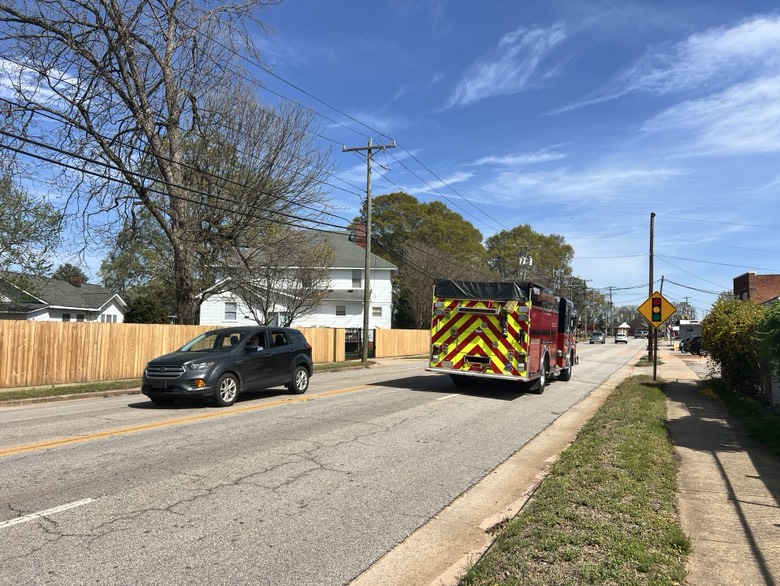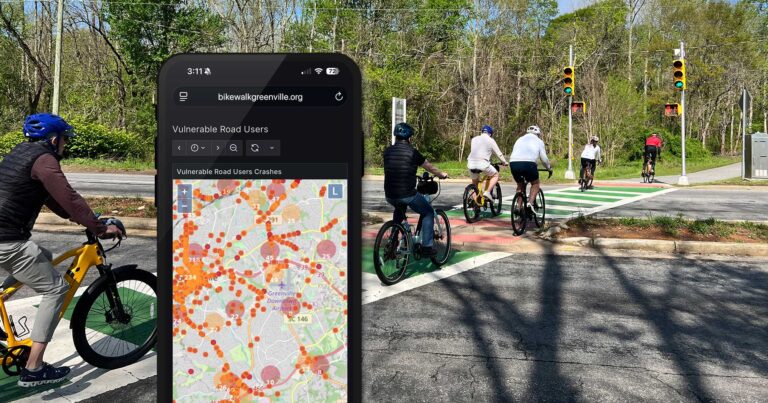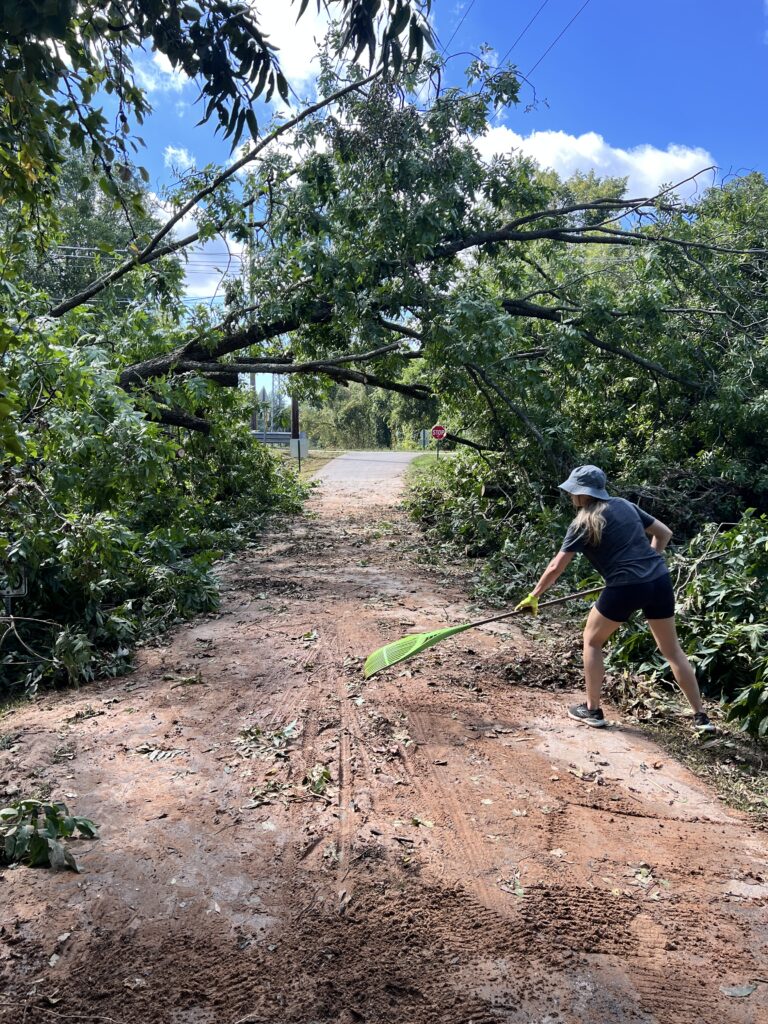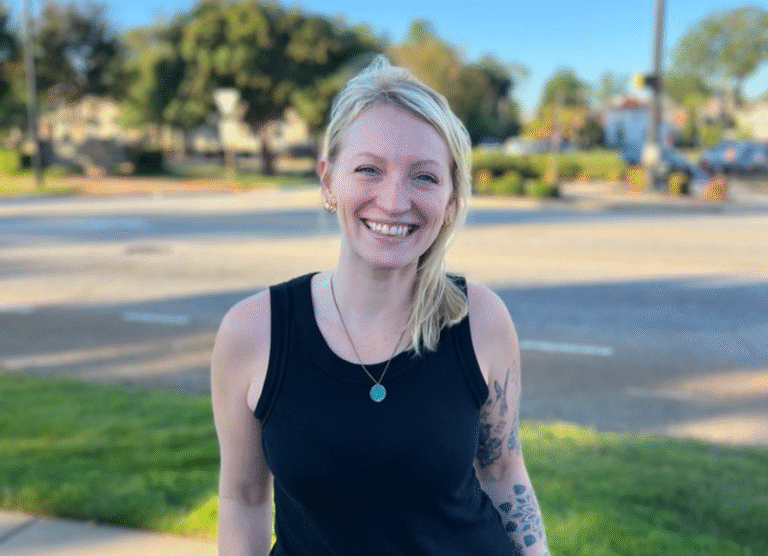
A Safer Future for Old Buncombe Road: Road Diet Project in Sans Souci
We’re excited to share a long awaited milestone in local road safety improvements: the planned road diet for Old Buncombe Road in the Sans Souci neighborhood. After years of advocacy, planning, and coordination, this four-lane roadway will be reconfigured into a safer, more efficient three-lane design—thanks to strong community support, dedicated collaboration, and funding secured in the South Carolina state budget.
Bike Walk Greenville is proud to have worked closely with the Sans Souci Neighborhood Alliance, the South Carolina Department of Transportation (SCDOT), and elected officials—especially Representative Patrick Haddon, who championed this effort at the state level and advocated for the allocation of funding for this project in the state budget. Our role included facilitating conversations, coordinating community feedback, and pushing for a design that prioritizes safety for everyone traveling through this area.
This is a big win for Sans Souci and everyone in Greenville who uses Old Buncombe Road — and for smarter, more people-centered street design throughout Greenville County.
Why a Road Diet?
Old Buncombe Road was last repaved about a decade ago. At the time, there was community interest in converting the four-lane layout to three lanes, but the effort stalled due to lack of support from local leadership and limited outreach capacity.
Fast forward to now, and a lot has changed. New businesses have moved onto Old Buncombe Road, and joined with residents in voicing concerns over the high crash rate and unpleasant experience of navigating this road in a vehicle, on foot and by bike. We now have stronger community partnerships, more effective outreach methods, and local leaders who understand that safe infrastructure improves neighborhoods.
The new design will convert Old Buncombe Road from four travel lanes (two in each direction) to three lanes: one lane in each direction, plus a center turn lane. This efficient configuration has been proven nationwide to reduce crashes, calm traffic, reduce maintenance costs, and make streets safer and more comfortable for drivers, pedestrians, and cyclists alike.
FAQ: Old Buncombe Road Road Diet
Q: What part of Old Buncombe will these changes affect?
This project focuses on the section of Old Buncombe Road between Cedar Lane/Pete Hollis Boulevard and West Blue Ridge Drive (SC-253). This stretch has the highest concentration of businesses and the highest crash rate, which is why it was prioritized.
Q: When will construction start?
The project has been funded and SCDOT has already sent it out to bid for a contractor. We expect construction to begin in late 2025 or early 2026.
Q: Why three lanes instead of four?
Research shows that four-to-three lane conversions on roads with fewer than 9,000 vehicles per day—like Old Buncombe Road—significantly improve safety and efficiency. Crash rates can drop by up to 40%, thanks to fewer blind spots, better sight lines, and a reduction in dangerous passing maneuvers. Drivers also benefit from a center turn lane, which allows smoother traffic flow.
Q: What other roads in Greenville have had this done?
While every project varies since no two roads are exactly alike, you may have seen similar projects on Woodside Avenue, Perry Road, and the South end of Augusta Street. The City of Greenville engineering staff has worked hard to improve road safety with its repaving designs in recent years, and we are thrilled to see these projects start to show up outside of city limits in Greenville County.
Q: Will there be bike lanes?
Unfortunately, no. The roadway varies in width, but in some sections is only 36 feet wide. A safe and legally compliant bike lane must be at least four feet wide, but there simply isn’t enough space within the existing roadway (changing roadway width and moving curbs quickly becomes cost prohibitive). The three-lane configuration (11-foot center lane and two 10-foot travel lanes) leaves no room for standard bike lanes. Still, the new design will reduce speeding and improve safety for people on bikes by improving sight lines and reducing blind spots.
Q: Will new sections of sidewalk be included?
While we’ve been advocating for sidewalk repairs and new sidewalk segments, the current bids suggest there may not be enough funding to install new sidewalks—particularly in the area near West Blue Ridge Drive (SC-253). We’re continuing to work with SCDOT to identify future funding opportunities to close those sidewalk gaps, and to use the maintenance budget to address cracked and damaged sidewalks that pose accessibility problems.
Q: What are the benefits for people walking?
The project includes new crosswalks and more sidewalk buffer space, creating a more comfortable environment for pedestrians. Calmer traffic speeds and fewer lanes to cross make walking safer and more pleasant.
Q: How does this help with emergency response?
The center turn lane provides a clear path for emergency vehicles to pass through, without weaving between lanes or getting stuck behind turning traffic.
Q: Why can’t all four-lane roads get this treatment?
Not every four-lane road is eligible. Roads must have low to moderate traffic volumes—generally under 9,000 vehicles per day. Roads like Stone Avenue or West Blue Ridge Drive (SC-253) carry significantly more traffic and would require more comprehensive redesigns to accommodate lane reductions safely.
Q: Can you just paint new lines instead of waiting for repaving?
No. Restriping without repaving leads to confusing and visually cluttered road markings, which can actually make conditions worse for drivers. Road diets should coincide with repaving for clear, high-quality lane striping that improves safety, not compromises it.
Q: What else can be done to improve Old Buncombe Road?
We don’t want this road diet to be the final chapter. We’re working on several complementary efforts to make Old Buncombe a safer and more welcoming corridor:
-
Tree Planting: In partnership with TreesUpstate, we’re identifying locations to plant shade trees. These help pedestrians stay cool and also naturally calm traffic speeds by making the street feel more like the neighborhood space that it is, not a highway.
-
Bus Stop Improvements: We’re collaborating with Greenlink to improve bus stop amenities. The Sans Souci Neighborhood Alliance is also encouraging residents to participate in the “Adopt-a-Stop” program so riders have safer, more dignified waiting areas.
-
Turn Area Consolidation: Fewer driveways means fewer conflict points. We’re working with local businesses to reduce the number of entrances and exits along the corridor while maintaining access and parking. This simplification makes the road safer for everyone.
This project represents a model for how community advocacy, data-driven design, and collaboration with state partners can lead to real safety improvements. We’re excited to see this plan become a reality and will continue advocating for similar efforts on eligible roadways across Greenville County.
Want to stay updated? Follow us on social media and sign up for our newsletter to get updates on this and other local active transportation projects.
Help Us Do More
Projects like this don’t happen by accident—they happen because of persistent, community-driven advocacy. If you believe in safer, more connected streets in Greenville County, consider supporting Bike Walk Greenville.
🧡 Donate here to help us keep projects like this moving forward.
Together, we can reimagine our streets—and make them safer for everyone who walks, bikes, rolls, or drives.


